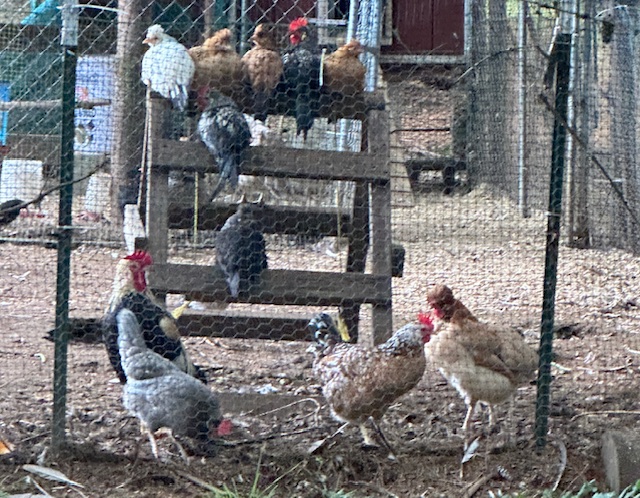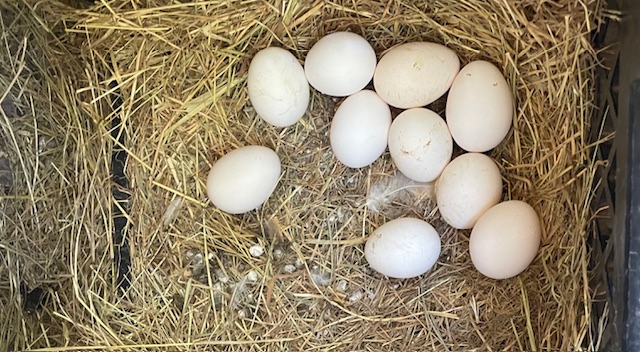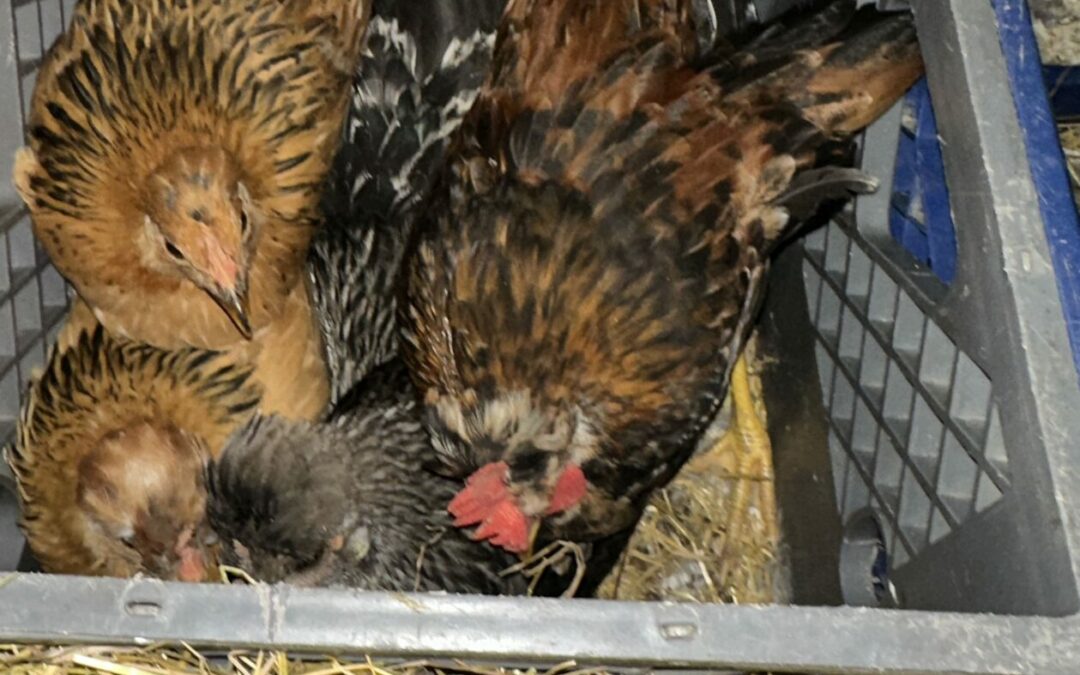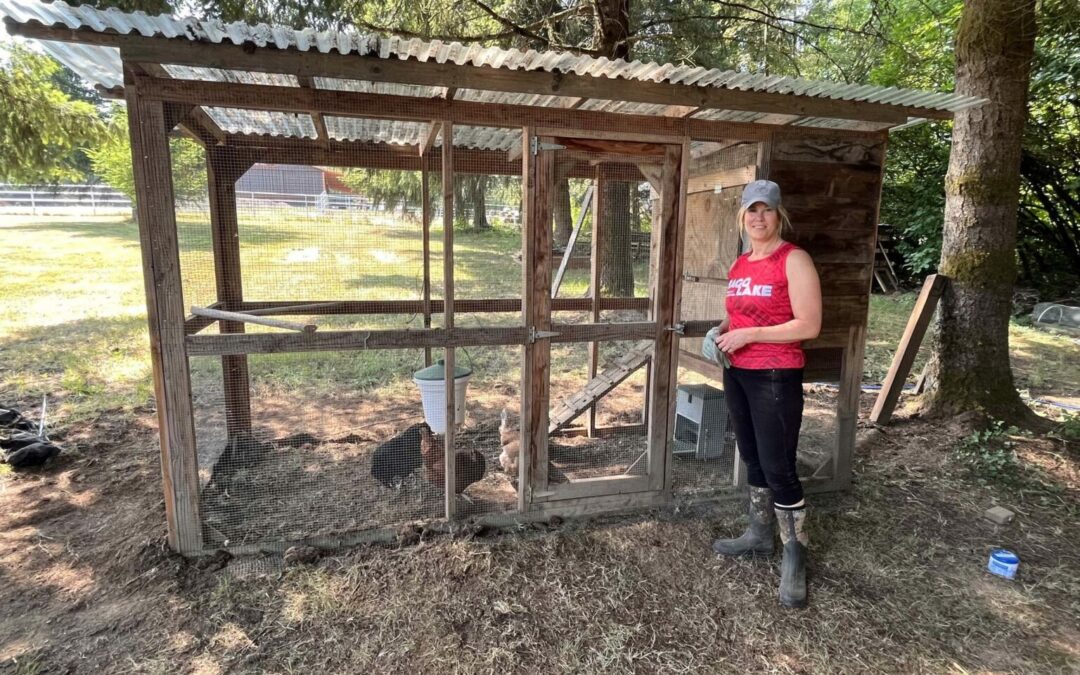
Please don’t say the F Word
My chicken coach is always looking for ways to spoil her chickens. I remember when she asked her husband to spend $50 on a chicken swing so they chickens could have something fun to play on and his response was there was no way they were spending that kind of money on a swing (I’m proud to say that I built my chickens a swing and all it cost me was the effort of assembling the swing out of recycled materials). My chicken whisperer takes her chickens for a walk after a good rain so they can eat all the worms on the driveway. These chickens owners really love their chickens and in return, the chickens reward them with eggs o’ plenty.
I enjoy my chickens as well. I enjoy watching them, especially after making a change in their coop. They are such inquisitive animals that they just can’t help but go check out any little change I make in their area: additional food, new toys, or even mice traps. They will inspect it, peck at it and inevitably start moving things around.
Since my chickens are somewhat famous, I frequently get asked, “Julie, what’s going on with your chickens?” Typically, I smile and say they are doing great.
However, last fall, when my chickens weren’t laying, I was frustrated. I was doing all the hard work and not getting the rewards for my effort. During this egg-laying drought, when people would ask me, “how are your chickens?” I’d respond with a sigh and say, “They are fine.”
As much as I enjoy watching the chickens, the purpose of having chickens is to have fresh eggs. And when they aren’t producing, it is frustrating. Yes, I still care for them, make sure they have food and water, clean their coop, and bring them treats, but without eggs, it isn’t all that much fun. I know that this dip in egg production is normal but I can’t help but wonder in the back of my mind if maybe this dip is due to something more than the seasonal lack of daylight. And this little thought tends to cloud my enjoyment of being a chicken mama.
As a business owner, I know that my business goes through normal cycles. But when sales are down or I’m having an issue with a client, it can be a bit unsettling. In my mind, I know this is normal and I need to stay focused on the bigger picture, but some days that feels so hard.
I know I’m not alone in feeling the weight of running a business that doesn’t seem to be performing at the level that it should be. This weight can lead to feeling like I did during my egg laying drought, and telling yourself and others, the business is “fine.”
When I’m implementing EOS with my clients, I tell them they are not allowed to say the “F word” in my session room. I don’t want to hear Fine or Sure from them. I want them to get energized, fired up, frustrated, angry, and excited. Because if the leadership team isn’t feeling that way, how can they possibly expect the employees to bring their best self to the business every day?
Yes, businesses go through really difficult times. And those difficult times require the leadership team to dig in and solve the issues that are preventing the business from moving through them. That desire to solve those issues requires energy. As Albert Einstein said, “You cannot solve a problem with the same mind that created it.”
A recent client was struggling with cash flow. They had grown very fast, and as you know, growth requires cash. But they were cash strapped and it was impacting every single aspect of the business. The leadership team walked into my session room with the weight of the business on their shoulders. The CFO was so stressed, she wasn’t sleeping, and the owner had made himself physically ill from the stress. “How are you?” I asked. “Fine,” they replied. “Are you excited for today’s session?” Sure, they sighed. The weight in the room was so heavy. I realized I had my work cut out for me that day.
When we got to issue solving, they were overwhelmed with how to work with the short-term cash flow issues while they secured the financing that was soon to come. We worked through the IDS (Identify, Discuss, Solve) tool, starting with identifying the issue, then listing potential solutions. At first, they let their current frame of mind limit their thinking, but I just kept writing down any idea they came up with. From there, the team identified some significant actions they could take to address the issue in the short term. As they looked at the list of actions, they started to perk up a bit.
I turned to the team and said, what do you think? Does this feel like we are identifying some solutions to address this problem? Instead of the “Sure” I had been hearing all day, I started to see some head nodding.
We took that momentum and turned to another issue that need to be solved. The team used the same process and came up with some great action-oriented solutions. I could see some smiles on their faces and I knew we were making progress.
I asked the team, do you think these actions will have a significant impact on your short-term cash flow issue? And the head of operations smiled and said, “Hell, yes!”
Your employees, your customers and your families need you to put the energy into solving the issues facing your organization with energy and passion. If you don’t have that, how can you possibly expect them to bring that energy?
Are you facing a challenge in your business and you aren’t sure how to solve it? Does your leadership team feel weighed down by these challenges and you aren’t sure how to energize them? If so, please reach out to me. I can work with you and your leadership team to provide the tools to help you solve the greatest challenges facing your business, so you can go from “Fine” to “Hell Yes.”




